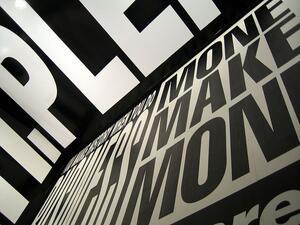Barbara Kruger
Barbara Kruger's work at the Australian Center for Contemporary Art.
Image courtesy of Wikimedia Commons.
Barbara Kruger used her classical training in design and her experience in the fashion industry to create conceptual art that pushed audiences to question assumptions about gender, violence, patriotism, and their relationship to the media. At age 22, she became chief designer at Mademoiselle. Kruger began creating pieces that used red and white text superimposed on photographs and advertisements to push viewers to rethink their assumptions. Her work was included in the prestigious 1973 Whitney Biennial, among other venues, and she has been commissioned for projects ranging from outdoor installations around the world to ads promoting art education in schools, as well as pro-choice and anti-domestic-violence PSAs. She also writes art criticism, has taught at many institutions, and as of 2014 is professor emerita at UCLA.
An image like a 1950s advertising poster of a girl looking admiringly at a boy making a muscle is captioned “We don’t need another hero” in red. A woman looking into a shattered mirror is underscored by the jagged headline “You are not yourself.” These works, by artist Barbara Kruger, are not only among the most easily recognizable in American art of the last few decades, but are also—through their relentless questioning of gender roles, consumer society, and the power of the media—among the most provocative.
Early Life and Family
Barbara Kruger was born in Newark, New Jersey, on January 26, 1945, into a lower-middle-class Jewish family. Her father was a chemical technician, her mother a legal secretary. Kruger studied at Syracuse University, the School of Visual Arts, and the Parsons School of Design. At Parsons, she took courses with photographer Diane Arbus and graphic designer and art director Marvin Israel. Although she never completed a degree in her chosen field, fine arts, Kruger’s association with Israel landed her a job with Condé Nast Publications. Within a year, at age twenty-two, she was chief designer at Mademoiselle.
Art Career
Her graphic design background is evident in her art, as is the influence of John Heartfield and Hannah Höch, two artists who used photomontage and collage techniques to create politically charged art in Germany in the 1920s. A kind of propaganda in reverse, Kruger’s works grab one’s attention much as an effective advertisement does, with one significant difference. Where advertising conceals its methods of persuasion, Kruger draws attention to them, asking us to scrutinize these methods, so as to better educate ourselves about the power of the media. The artist uses advertising’s techniques—enticement, shock, provocation, and a direct address to the viewer—in order to teach us how the two languages of persuasion, photographs, and words, influence us. Believing that no message is neutral, Kruger would have us be critical interpreters, rather than passive consumers, of the media.
Entering the New York art scene of the late 1960s, she found a largely male world not welcoming of women artists. But she was inspired by the efforts of another woman artist, Magdalena Abakanowicz, and began to make art under Abakanowicz’s influence. The 1970s were a time of steady intellectual and artistic growth for Kruger. Her art was exhibited in the prestigious Whitney Biennial and several other group and solo exhibitions. Beginning in the mid-1970s, her reading and participation in a group called Artists Meeting for Social Change introduced her to feminist film criticism and structuralist literary theory, which were to shape her work as a mature artist. These influences drew her away from her previous artistic efforts, which she came to consider as lacking in intellectual challenge and political content. Inspired by new ideas and her own graphic design experience, Kruger began developing a signature style and subject matter. She also started to teach, to write criticism about television and cinema, and to curate exhibitions, which centered on her interests in advertising and media.
Kruger has exhibited in galleries and museums in the United States and Europe. Perhaps more significantly, she has brought her art to such urban public spaces as bus stops, subway stations, and billboards, thus appropriating advertising’s domain for her own message. She has contributed criticism to the journal Artforum and has published anthologies of her writings. She makes her home in New York.
Selected Works by Barbara Kruger
Beauty and Critique (1983).
No Progress in Pleasure (1982).
Picture/Readings (1978).
Remote Control: Power, Cultures and the World of Appearances (1993).
T.V. Guides: A Collection of Thoughts about Television (1985).
Alternative Museum. Contra Media: Hans Haacke, Barbara Kruger, Michael LeBron, Erika Rothenberg (1982);
Dunford, Penny, ed. A Biographical Dictionary of Women Artists in Europe and America Since 1850 (1989);
Foster, Hal. “Subversive Signs.” Art in America 70, no. 10 (1982): 88–92;
Linker, Kate. Love for Sale: The Words and Pictures of Barbara Kruger (1990);
Marks, Claude, ed. World Artists 1980–1990 (1991);
Pohlen, Annelie. “The Dignity of the Thorn.” Artforum 21, no. 1 (1982): 59–61;
Squiers, Carol. “Barbara Kruger.” Aperture 138 (1995): 58–67, and “Diversionary (Syn)tactics: BK Has Her Way with Words.” Artnews 86, no. 2 (1987): 76–85;
Who’s Who in American Art 1993–94 (1993).




